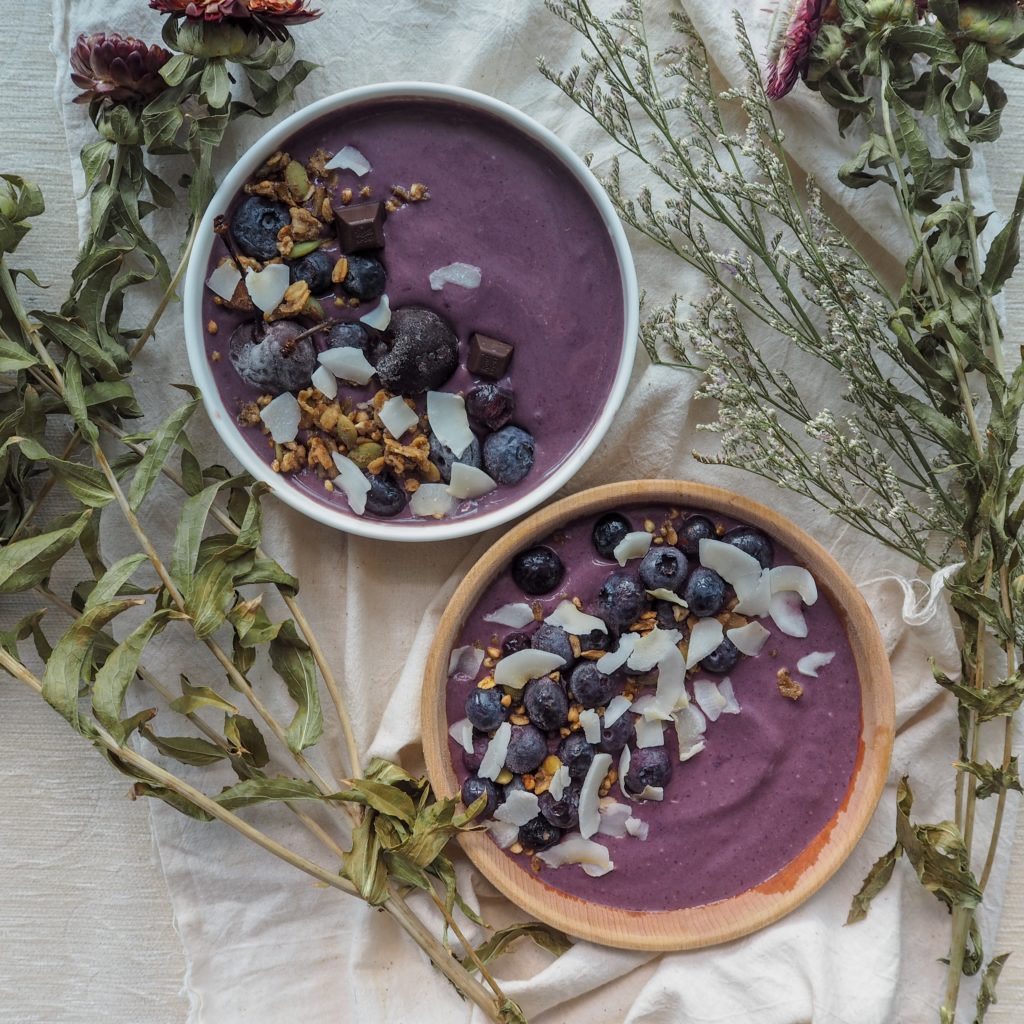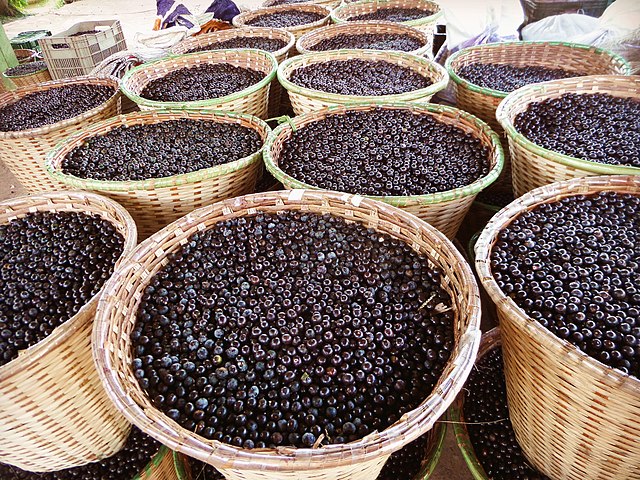I heard the story about the “fruit that cries” when I was around nine or ten. A crack of thunder sent my friends and me—each equipped with a popsicle—back inside the school building. When I re-entered the classroom, I had açaí all over the back of my t-shirt. The teacher called attention to the stains that otherwise would go unnoticed until I got home, and asked me if I thought the raindrops were Iaçã’s tears. As I was clueless, she went about with the tale of the origin of açaí:
“In a dark period of the pre-Columbian era, the indigenous Tupi chief Itaki imposed the killing of every newborn in the tribe, so as to prevent his people from starving. Itaki maintained his orders even when his daughter, Iaçã, gave birth to a girl. Amidst tears throughout days, Iaçã prayed for god Tupã to reveal other ways for Itaki to ensure food to the tribe. After some time, a loud cry in the forest broke Iaçã’s sleep in a cloudless night. Entering a grove, she found her daughter sitting by a palm tree. Iaçã ran to the child, but the baby vanished in their embrace.
Devastated, Itaki’s daughter melted in tears under the palm tree. When the first rays of sun illuminated Iaçã’s face, those who found her noticed that her black eyes fixated in equally dark fruits on top of the plant. The men of the tribe harvested these fruits and extracted a thick, nutritious juice from them. Itaki understood those fruits were sacred – gifts from Tupã – and named them to honor his daughter: açaí (Iaçã spelled backwards), the fruit of her tears. As açaí brought abundance to the tribe, every newborn was welcome, and all prospered.”
I remember feeling heavy after hearing about Itaki’s family fate. To me, açaí meant so much joy. For a long time, I used to share it with my mom under the big Amazonian skies every other week of the harvest season. We ate it, and still do, with a driblet of sugar and some manioc or tapioca flour. Although elaborate açaí bowls have made it to distant corners of the world, its traditional form of consumption does not include anything other than the ingredients my mom and I add.

An elaborate and healthy açaí bowl with blueberries, coconut, seeds, and dark chocolate.
I have heard açaí tastes like earth and needs milk, granola, and other fruits to mask that. For my taste, it is precisely this earthy hint that does the trick. It brings me back to my roots and fills me with bliss, reminding me of where it comes from. As açaí flows in my bloodstream it does not only nourish my body, but also my sense of identity and relationship with nature.
There are 16,000 tree species in the Amazon, out of which only 227 constitute more than half of the 390 billion trees that exist in the biome. Açaí palms (Euterpe oleracea Mart.) figure among these abundant—or hyper-dominant—species. There are 3.78 billion açaí palms in the rainforest, so consuming their fruits does mean incorporating a large portion of the Amazon into our bodies.
Scientists believe that beyond being more resistant to diseases and herbivores, hyper-dominant species have flourished because indigenous populations have cultivated and domesticated them across millennia. These species are more easily found around ancient settlements and provide humans with an abundance of services. Domesticating species like açaí, these peoples have shaped the Amazonian ecosystem, favoring the growth of plants that are important carbon sinks and improving soil fertility.
Besides adorning the forest—Euterpe, another name for acai, is a Greek goddess whose name means “forest elegance”—açaí palms contribute with the carbon, nutrients, and water cycles, as well as with biomass generation in the world’s largest rainforest. The stretched leaves constantly fall, protecting and fertilizing the soil in their decomposition process. The increased appreciation of açaí has moreover increased the protection of natural vegetation, afforestation, and preventing deforestation in some areas of the Amazon.
Awash with proteins, amino acids, vitamins, fibers, healthy fats, and antioxidants, açaí has the power to increase energy levels, support muscle development, and strengthen the immunological system. These properties have caught the attention of sportspeople–especially surfers—in Rio de Janeiro. From there, the marble-sized fruit traveled to São Paulo and many corners of the world, becoming the “purple gold” of the Amazon. Nowadays, açaí is also a protagonist in natural skincare products due to its anti-aging properties.
Since açaí journeyed out of the Amazon borders, its commercialization has been generating roughly 40 million Brazilian Reais—currently 7.7 million US Dollars—per year. The açaí market has favored the creation of 25,000 jobs, including harvesting, transportation, commercialization, and processing activities. In the harvest cycle, açaí festivals infuse river communities with different rhythms, colors, and aromas. Boats bristling with açaí whizz throughout the night, making their way to local markets and distribution centers for days in a row.

Several baskets brimming with açaí, the result of many hands’ efforts in the harvest season
However, the economic prosperity the fruit is bringing has a dark side: other plant species are being cut down to open space for açaí saplings. Worse than that, large-scale farmers are now investing in açaí plantations in Pará. Causing a decrease in biodiversity, the expansion of açaí monocultures can seriously disrupt the rainforest at the local and regional scales. Additionally, when açaí plantations replace cattle ranches in upland (dry) forest areas, the plant—adapted to wet environments—requires irrigation and toxic agrochemicals.
Some açaí cultivators do respect the forest structure and diversity, and affirm that palms grown in the shades of high tree species produce finer fruits. These tree species include andiroba, copaiba, Brazil nuts, and rubber trees—all of which provide commercially attractive non-timber products. These are the people we need to support. If we can ensure the açaí we buy comes from the hands of cooperatives that respect and reproduce the culture around this sacred fruit, we can boost its ecological, cultural, and economic benefits.
Sambazon—Save and Manage the Brazilian Amazon—is a company purchasing organic açaí pulp from such cooperatives. Their açaí, which fills glasses and bowls in the United States and United Kingdom, is entirely traceable to the community who cultivated it, and provides cash up-front to the people producing the pulps. Innocent, Happy Monkey, and The Berry Company products do contain fair-trade, organic, and sustainable açaí. Going for these brands, we can help to prevent further pain among Amazonian peoples.
Get more like this—Sign up for our daily inspirational newsletter for exclusive content!
__
Photo: Unsplash; Wikipedia Common




